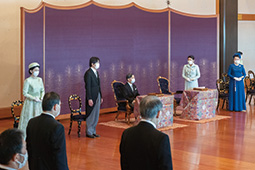
Ceremony of the Utakai Hajime on 26th March 2021 
Their Majesties the Emperor (center) and Empress (right of center) and other members of the Imperial Family at the Ceremony
June 2021
Ceremony of the Utakai Hajime

“Ceremony of the Utakai Hajime” (Imperial New Year’s Poetry Reading), an annual court event, was held in Seiden-Matsu-no-Ma (State Room) of the Imperial Palace on 26th March 2021. The event, which is normally held every January, was held in March this year in consideration of increasing COVID-19 infections.

The Past and Present of “Ceremony of the Utakai Hajime”
“Utakai” (Poetry Reading) is a gathering of people who get together to read a collection of waka* poems on a common theme to a wider audience. This practice was already in usage during the Nara period (710–794), and became known through the famous volume of Japanese poetry, the Manyoshu**.
An Imperial Poetry Reading is the same as the above-mentioned description, the only difference being that the poetry reading is convened by the Emperor. The Imperial Poetry Reading was held as the first such party of the New Year, and was given the name Uta Gokai Hajime (original name). The origins of the Utakai Hajime are unclear. However it was recorded that Emperor Kameyama convened an Imperial Poetry Reading at the Imperial Palace in January 1267 in the middle of the Kamakura period (late twelfth century to 1333). Since that time, records of the Imperial New Year’s Poetry Reading have been found down through the ages. From such evidence, it can be surmised that the origins of the Utakai Hajime are traceable to the mid-Kamakura period.
In the early modern period, the Utakai Hajime came to be held almost every year through the Edo period (1603–1867), and in the Meiji period (1868–1912) the first Utakai Hajime during the reign of Emperor Meiji was held in January 1869. Since then, among various reforms in ceremonies, the Utakai Hajime has continued to be held.
From 1874, poems written by the general public were admitted for consideration for the first time, and the Utakai Hajime in the Imperial Palace thus became open to the people of Japan, and no longer the preserve of members of the Imperial Family, grandees and their entourages.
In 1879, of the poems submitted by the general public, those considered to be of special merit were chosen to be read out at the Utakai Hajime. This was a groundbreaking development in the history of the Utakai Hajime and established the precedent for commoners to be included in the Ceremony of the Utakai Hajime at the Imperial Palace.
Since 1882, all poems recited at the Ceremony of the Utakai Hajime including those by the Emperor and the specially selected poems have been published in newspapers and since 1884 they have also been published in the government gazette.
In 1926, the Imperial Family System Decree was promulgated, and this Decree mentioned the program of the Utakai Hajime. Since then, the Utakai Hajime (the original name “Uta Gokai Hajime”) became formally known as the Utakai Hajime.
After World War II, in order to elicit the submission of more poems from a wider range of people, the subject for the poems was made simpler. Furthermore, it became possible for those people whose poems were chosen to attend the Ceremony of the Utakai Hajime, and they have the opportunity to have an audience with Their Majesties the Emperor and Empress. In addition, live television coverage has been introduced, bringing the spectacle of the Ceremony of the Utakai Hajime to an even wider audience and promoting national participation and enjoyment of the Ceremony.
As a result, the Utakai Hajime at the Imperial Palace boasts a long history and represents a ceremonial culture that has become more sophisticated and a cultural event with national participation in a way that is unique in the world. The total number of poems submitted by the general public was 14,102 this year and 16,002 last year (2020). The Ceremony of the Utakai Hajime demonstrates the power of poetry to bind the people together with the Imperial Family. These waka poems are heard and read not only in Japan, but also overseas. Waka, said to be at the heart of all traditional culture in Japan, is spreading around the world.
The Proceedings of the Ceremony
The Ceremony of the Utakai Hajime is attended by Their Majesties the Emperor and Empress, and poems are recited including those chosen from submissions by the general public, poems of the selectors themselves, and poems by professional poets. Finally, the poems of the Imperial Family, Her Majesty the Empress and His Majesty the Emperor are recited (see the poems of Their Majesties the Emperor and Empress on this page). Other members of the Imperial Family, a minister of state, members of the Japan Academy of Art and the members of the public whose poems have been chosen are present at the Ceremony of the Utakai Hajime.
His Majesty the Emperor, holding the Ceremony of the Utakai Hajime, decides the theme of poem. The theme of this year’s poem was zitsu (fruit).
The ceremony is performed through several participants, each with special titles: the dokuji (a master of ceremonies), koji (a reader of all poems), hassei (a singer of poems from the first poem), and kosho (accompanying singers to the hassei for poems from the second poem).
Note: This article has been created with the consent of the Imperial Household Agency and on the basis of materials published by the Agency.
* A classic Japanese poetic form consisting of 31 syllables divided into five parts with five, seven, five, seven and seven (5-7-5-7-7) syllables in each. Nowadays, it is also called “tanka.”
https://www.gov-online.go.jp/eng/publicity/book/hlj/html/202010/202010_02_en.html
** The oldest anthology of waka poems, which is said to have been compiled from around the second half of the seventh century, and contains a wide assortment of waka, ranging from poems composed by emperors to those composed by common people.
Theme for the New Year's Poetry Reading (2021): ZITSU (FRUIT)
His Majesty the Emperor
I sincerely pray that
The hope and efforts of the people
Bear beautiful fruit
Leading us to peaceful days
(Background of the poem)
Their Majesties the Emperor and the Empress are deeply saddened to have learned that the spread of COVID-19 last year has claimed many lives all over the world, and that people are still being confronted with enormous challenges.
Under these circumstances, wishing to further understand the situation of and turn their thoughts to the many people who are faced with these difficulties, Their Majesties have listened to experts in various fields and to those actually involved in handling the situation.
His Majesty the Emperor composed this poem, sincerely praying that the peoples’ hopes and the efforts of those working together to overcome the difficulties bear fruit and thus the pandemic will come to an end.
Her Majesty the Empress
As I stand in the garden
Yearning for
The end of the infection’s spread,
The fruit of the ume
Are a hopeful green
(Background of the poem)
Their Majesties the Emperor and the Empress have been hoping earnestly for the containment of the infection ever since the COVID-19 breakout. Last May, during the time when the state of emergency was declared, Her Majesty the Empress Masako was taking a walk in the Akasaka Palace grounds. As she paused by the Japanese apricot (ume) trees, she found that the fruits had grown and become fresh green. Even though the daily lives of people had changed greatly in many ways by the spread of the infection, the Japanese apricot trees had bloomed and were bearing fruit just as in years before. Her Majesty was moved by the unswerving vitality of the workings of nature. This waka poem was composed to express Her Majesty’s impression at that time.
Theme for the New Year’s Poetry Reading (2021): ZITSU (FRUIT), The Imperial Household Agency, the Japanese government (https://www.kunaicho.go.jp/e-culture/pdf/utakai-r03.pdf)


